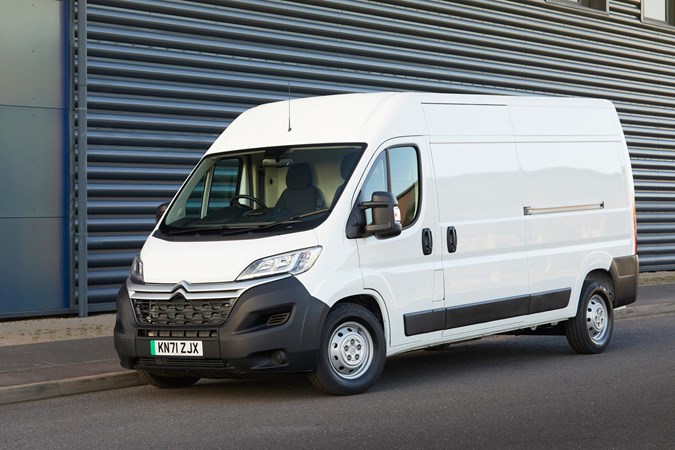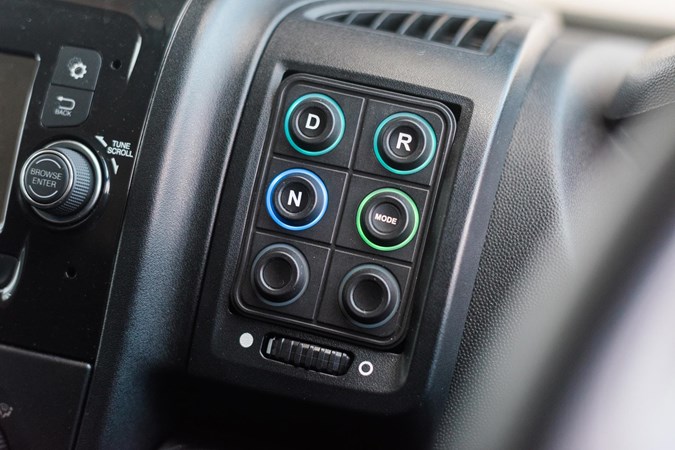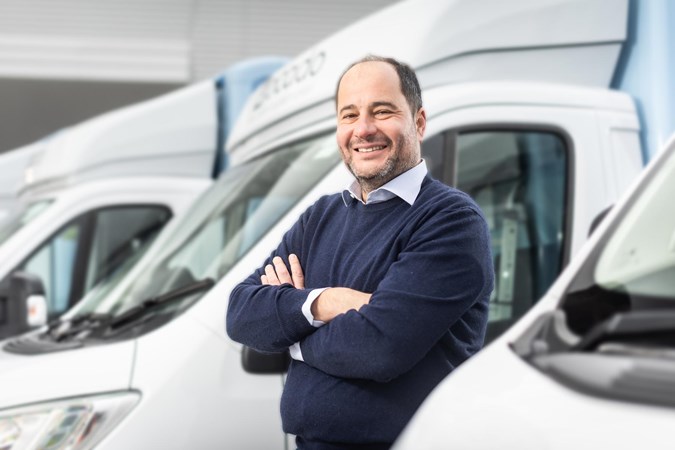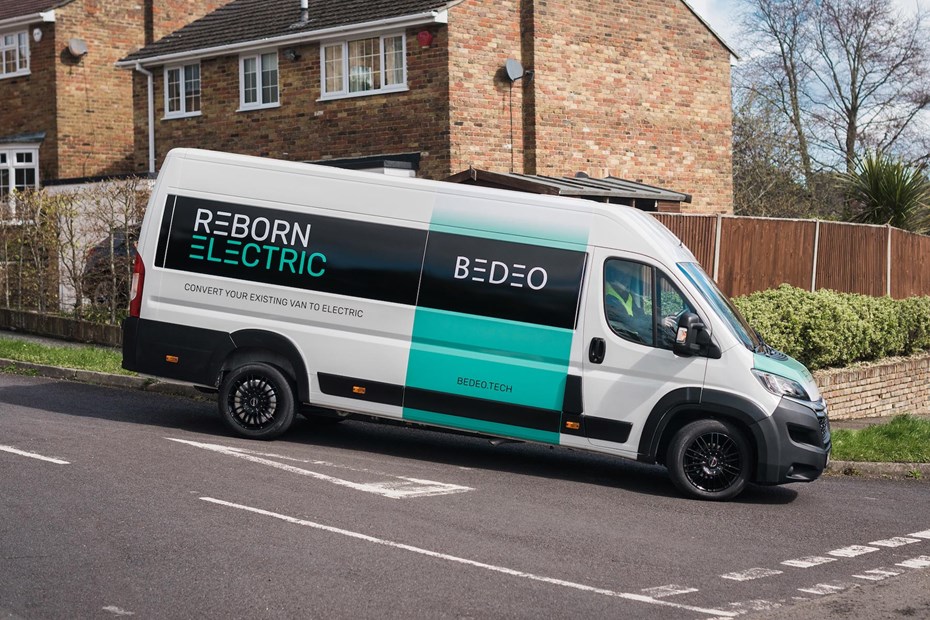The light commercial vehicle industry has largely skipped the plug-in hybrid or range extender phase, with many manufacturers making the leap straight to electric vans.
If you want to run on electricity part of the time, but retain the long-range ability of a combustion engine, then your options are limited to just a couple of vehicles from major manufacturers – the Ford Transit Custom and the LEVC VN5. Ford is sticking with offering a plug-in hybrid electric vehicle (PHEV) version of the next generation of Transit Custom, so it reckons there is some demand for the technology.
Conversion specialist Bedeo reckons that there is a huge opportunity here, and that there will be plenty of van owners that will want to go down the part-electric, part-diesel route. However, it isn’t offering a brand-new van – it is targeting existing owners that want to convert their vans from pure diesel into something capable of zero emissions.
It’s called the RE-100 and Bedeo reckons it will be good for 117km (73 miles) of electric range thanks to its 37kWh battery. The engine remains in place and untouched, so you can still fall back on that for longer trips.
First things first – who is Bedeo?
The Bedeo name might sound familiar, but only to keen observers of the electric van market. It is a British company, based in Surrey, and is the company behind the EV conversions of the Citroen Relay and Peugeot Boxer large vans.

You might also have seen ‘BD’ preceding the name of a few models on the list of approved vehicles that are eligible for the plug-in van grant. That’s because it also converted a few other vehicles beyond those under its former name of BD Auto – it has converted Renault Trafics and Fiat Ducatos off its own back in the past.
It has worked with major companies such as Ocado, DHL and TNT, helping fleet managers adopt electric vehicles when the manufacturers might not have been able to help out. They take the original vehicle, strip out the combustion engine and various other associated parts and install an electric motor and battery.
How does the RE-100 work?
The RE-100 takes a different approach to the full electric conversions that Bedeo has created in the past. The engine remains in place, which means that the motor has to go somewhere else. Bedeo uses two in-wheel motors of Bedeo’s creation that are fitted in the rear wheels of the vehicle.
The battery is also one of Bedeo’s own, and is designed so it doesn’t impose into the load-bay space, which means that the storage area is unaffected. The company says that it is able to replace the whole axle without impacting the ride height and suspension, which means that ground clearance remains the same.
In some senses it is a very simple prospect – everything at the front of the vehicle remains unchanged and Bedeo, in basic terms, just plugs in the battery and components. The track remains the same and the wheel bearing is a conventional one.
It does mean that the conversion can only be offered on a front-wheel drive van. The motors drive the rear wheels, while the engine continues to drive the front ones.
The wheels themselves are slightly larger – they are 18-inches in diameter for the launch motor, but Bedeo will be able to provide steel wheels as part of the package. There are winter and summer tyres that will fit onto them, but they are only available from Nanking to start off with.
What is the Bedeo RE-100 like to drive?
Everything about the Bedeo RE-100 converted Citroen Relay that we try out looks and feels remarkably normal, both inside and out. This is testament to how well the extra tech has been integrated on the surface of things, but is also notable given how clanging the official Citroen eRelay conversion is. Outside, the only obvious elements are the alloy wheels and the visible motors tucked behind the rear ones.
In Citroen’s fully electric Relay (also converted by Bedeo) there are signs all over the cabin that make it very apparent that everything has been installed into a vehicle that wasn’t designed to run on anything other than its original engine. The dials on the dash remain unchanged, but simply have the arms removed for example.
Because the RE-100 conversion still has its diesel engine, the rev counter dial and fuel gauge are both still needed, so it looks less jarring in its integration.
The Bedeo RE-100 on the move
The van starts in electric mode but can be switched over to diesel manually for longer drives thanks to a small supplementary panel on the dashboard that has a couple of buttons designed for this purpose. It features a D, R and N button, which act as the automatic gearbox, and a ‘Mode’ button, which allows you to switch over from electric to diesel or vice versa.

If you simply start the van up and begin driving, then it feels just like driving an EV – mainly because that is what you are doing. All the systems work on EV mode, the radio, climate control and all the read outs for example.
We only had a short stint behind the wheel, but performance feels largely similar to the eRelay. That means it doesn’t offer a huge burst of pace and low-end torque, instead going for smooth and steady, which should be fine for the urban areas where the electric is most appropriate.
The RE-100 is not like any other plug-in hybrid on the market, though. It is not really a hybrid at all as it is not able to switch between its two modes of power on its own accord. If you want to start off in diesel mode then you need to turn the ignition key one turn, then pressing and holding the mode button before completing the key turn.
If you want to switch between electric and diesel once you have started then you need to move the gearbox into neutral and pressing the button. Theoretically it is possible while moving, but this means cruising while not in gear so it is far better to do so while stationary.
It is simpler to switch to electric mode, and Bedeo says that it will be possible to do so using geofencing technology in the future. This isn’t possible right now, though.
What impact does the added kit have on practicality?
Bedeo has managed, thanks to the in-wheel motors, to ensure that there is no physical encroachment onto the loading space, but the addition equipment inevitably has an impact on the van payload.
It has not given precise figures, but Bedeo founder and CEO, Osman Boyner, says that the payloads are comparable to the battery-powered Relay and Boxer. This means that there is around a 500kg reduction in overall carrying ability. This means a payload of around 700kg to 1,000kg, depending on the base vehicle.
What extra maintenance does the RE-100 need?
Theoretically, says Bedeo, there should be no additional servicing or maintenance for the extra electric elements. There is no need for regular servicing, and Bedeo has carried out extensive testing for pothole strikes. It should be able to survive 120 100G shocks, it says, while it has also been tested for kerb strikes and should be able to cope with those in just the same way as a standard axle.
Should there be any major damage, then it will be able to send a ‘check engine’ alert that displays on the dashboard, but if there is a fault then it is a case of replacing the whole motor rather than repairing it. However, each motor can be replaced separately – they don’t need to be both changed together.
Who is the Bedeo RE-100 aimed at?
Boyer says that there are a couple of motivations for potential RE-100 buyers.
‘It depends on the fleet size, ‘he says. ‘The larger the fleet size there is more corporate sustainability involved, the smaller the fleet size it is more a case of saying: ‘I have spent £15,000 on the back of this vehicle on racks etc and I don’t want to spend this again. And you are getting a new powertrain – if you are five or eight years with a diesel you are spending a lot to maintain that.

‘Why do people terminate a vehicle after five years? Perhaps because it looks old, but also the expenses of the maintaining the engine and all that just jumps higher.
‘What is the motivation to make that choice? It’s money and the image. So we are giving you an electric vehicle but much cheaper than buying a new electric vehicle.’
He says that the main target is smaller companies, SMEs with five to 10 vehicles rather than large fleets.
How much will the Bedeo RE-100 cost?
Sales of the Bedeo RE-100 will take place through dealers – Boyer reckons that the franchise retailer network is open to new options as they have been treated badly by manufacturers in recent years. He points also to the specialist dealer network for vehicles such as campervans.
Boyer is remaining tight-lipped on pricing of the conversion but says that there is a menu available, with Bedeo set to offer more than just the installation of the electric tech. It will also refurbish the van inside, including the cabin, should you wish to breathe new life into the vehicle as a whole.
However, he says that the reduced running costs that come as a result of saved diesel could bring a return on investment within a relatively short period of time.
‘We’re looking at a three-to-five-year return [on investment],’ he says. ‘When you have stuff on the back, it gets accelerated down to one year because you don’t have to spend on refitting a new vehicle.’
This is based on users covering 85% of their miles in electric and just 15% in diesel. There will be a small period of downtime to factor in too, as the conversion will take a few days but no more than a week. This seems swift for what is a fairly big job, but still needs consideration. Ultimately, Bedeo reckons it should be able to convert up to 20,000 vehicles a year when it is up to full speed.
Unfortunately, despite the conversion, the vehicle cannot be reclassified as an electric van, which means it is still not eligible for the exemption to congestion charge zones that EVs are able to enter free of charge. All other taxation would remain as if it were still a diesel, so the only savings are on fuel.
It is currently not eligible for the London scrappage scheme that provides some funding for converting vehicles to electric. Boyer laments this fact but points out that its full electric conversions, which it still offers, are theoretically eligible for such grants.
Bedeo is pushing for more help from the government in terms of recognition on this front, and is also set to announce more details on pricing in the coming weeks.
Verdict: should you convert your existing diesel van to a range extender?
It’s easy to hide behind caveats when coming up with a verdict in cases such as this, as there are so many factors involved. For a start, this is an unusual approach that requires you, and your company if they are involved, to take a bit of a leap. There are some financial benefits as you might well be able to extend the life of an existing vehicle with an expensive conversion on the back.
However, wear and tear on a vehicle occurs on more than just the engine, so putting in a new powertrain won’t prevent other elements from suffering from age-related degradation. It might be more worthwhile on a younger used van than one that has already had a hard life. The end result certainly feels more integrated than the Citroen and Peugeot pure electric large vans, but this isn’t hard given the odd nature of those vehicles.
Currently Bedeo is concentrating on the large, 3.5-tonne sector, and can work with the Citroen Relay, Fiat Ducato, Peugeot Boxer and Vauxhall Movano, but hopes to be able to convert every large van in time.
There are certainly thousands of potential vehicles out there for conversion, but finding those willing to take the leap is the first challenge facing Bedeo.
Just so you know, we may receive a commission or other compensation from the links on this website - read why you should trust us.










